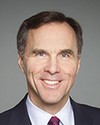In our campaign, we talked very clearly to Canadians about what we see as a fundamental challenge that's been going on in Canada for the last several decades.
When you look at the changes in the economy, when you look at the productivity growth in the economy, you can see quite clearly that the returns from that growth have gone more to the very top of the economy than it has to those in the middle.
We recognize that this is fundamentally part of the policy choices in Canada. We also know that in dealing with how Canadians are able to prosper in the future, we need to think about how to deal with that situation.
We put in place specific measures that we believe can help the broadest cross-section of Canadians. We put in place a tax reduction for those people who we see have not been able to grow their income as rapidly as others. Specifically, our target was the income tax bracket between $45,000 and $90,000. We reduced taxes for people in that category by 7%.
We increased taxes for those who have done very well over the last several decades by increasing the tax rate for those who make over $200,000. In effect, when you consider the impact of those two tax rates together, it means that people earning over $217,000 pay a slightly higher amount of tax.
We think this is the right thing to do. We recognize that it deals with the fact that the middle class has not done as well over the last number of decades. It starts us on the right path to ensuring that the impact of positive income growth in this country is shared equally among different Canadians.

